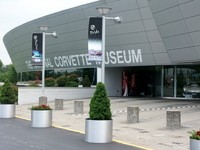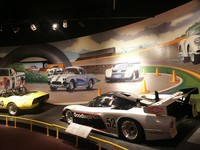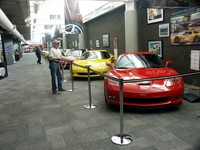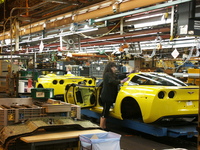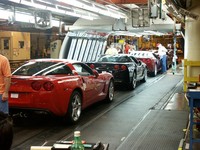Corvettes Old and New; Preserving, Building and Racing The Icon
CORVETTES, NEW AND OLD
Preserving, Building and Racing The Icon
By Steve Purdy
TheAutoChannel.com Detroit Bureau
THE MUSEUM
Let’s just call this our Corvette day. We figured about a three-hour drive shunpiking (taking the back roads) from our Tennessee resort to Bowling Green, Kentucky where we’ve arranged tours of both the National Corvette Museum and the Corvette/XLR assembly plant across the street. In spite of slow trucks and old folks – the “anti-destination league” – we made it on time while enjoying the rolling, lush hills of Southern Kentucky. In spite of the hills and curves there were opportunities to pass and our GMC Yukon’s 5.3-liter Vortec V8 was up to the task. It was a bit noisy past 4000 rpm and really sounded like it was working. But acceleration was good for such a big brute.
The National Corvette Museum is not a GM entity although the corporation provides generous in-kind services as well as regular loans of special cars from the corporate collections. Rather, the museum is owned and managed by The National Corvette Museum Foundation.
Our tour guide, Roc Linkov, came to the museum in 2003 after organizing museum events as a volunteer. Roc is now the events manager in charge of eight major events at the museum and another two dozen off-site, including high-performance driving (not racing) schools which accommodate about 70 students each and Corvette corrals that draw between 200 and 400 cars at American LeMans racing events. We’ll check one of these out at Mid Ohio race course on our way home and report for you, our dedicated readers.
Like many of the best automotive museums one could get a good sense of the collection and be well entertained in a few hours or one could spend a good long day being immersed in each display, soaking up Corvette history like a true aficionado. We were fortunate to have Roc along to point out the highlights and provide a bit of back story. For example, if we were browsing by ourselves we could easily miss the small display showing the original Corvette hood badge, which featured the American flag as one of the crossed flags. Or we might not have noticed the railing that is made from the raw materials of the hydroformed steel frame pieces used in the new Corvette’s substructure.
About a third of the Corvettes on display are owned by GM or the museum and the rest are privately owned. Each private car stays about a year and is special for some particular reason. It’s considered a great honor to have one’s Vette in the museum and there is substantial competition for these spots.
On of my favorite displays is one dedicated to Zora Arkus Duntov, the engineer who brought the wimpy but cool, six-cylinder ’53 and ’54 Vettes into performance respectability with the small-block V8 in ’55. Duntov was Corvette’s chief engineer for many years and his ashes reside in an urn at the museum next to the only Covette he ever actually owned, a ’74 coupe. Beside his urn is a Champaign bucket with a bottle of bubbly, both awaiting the ashes of his wife when her time comes.
Other intriguing displays feature Corvette engines, tires and substructures, a Route 66 display, a Corvette hall of fame, and an extensive racing display. Corvettes from every year, including the only ’83 which was barely saved from the crusher, are just a small part of the museum. You’ll see Bill Mitchell’s Mako Shark, the restored Gran Sport #2, the only “torch red” C-6, and plenty more.
Another fun feature of the museum is the “Nursery.” Usually six brand new Corvettes are lined up behind a rope awaiting the arrival of new owners to take them home. Customers can purchase their new Corvette at their local dealer then have it prepped and delivered at the museum. That $490 service includes private guided tours of both the assembly plant and museum. In fact, in some cases during the factory tour a new owner can get into the car at the end of the assembly process and be the first to start his/her new car.
There are thousands of Corvette clubs around the country but they are not particularly well organized or integrated outside of a few regional groups. The National Corvette Museum is rapidly becoming the clearing house for Corvette information and activities nationally through a website, newsletter and activities. They’re becoming essentially the national Corvette club.
The National Corvette Museum has been around for about ten years now and it is now firmly established. The special events have gone a long way to stabilizing the funding base and bringing in members. Roc has arranged for us to attend the Corvette Corral at the American LeMans race at Mid Ohio race course on our way home, one of many off-site special events the museum organizes. The next thrust at the museum, Roc reports, is to begin making the displays more interactive. About 150,000 visitors a year come to the museum.
Few cars have inspired the kind of loyalty and dedication of the Corvette - still, some argue, America’s only true sports car. Sure the Viper might qualify, but it’s hardly roadworthy in the daily-driver sense. And, of course, the new Solstice and Sky are American sports cars in the Miata mode, small, agile and fun, but not especially awesome. The Corvette is still true to Duntov’s original concept of an affordable, road worthy, high-performance, two-seat sports car. And that, my friends, is why it remains so popular and why it inspires such lust and loyalty.
The museum is open from 8 AM to 5 PM, seven days a week all year except a few days around Christmas. Admission is $8 for adults, $4.50 kids or $20 for the whole family. Memberships in the National Corvette Museum Foundation range from $20/year for a youngster or “New Generation” member, and $50 for an individual to a lifetime business membership at $2500 and other levels in between. Check out both the museum and memberships at www.corvettemuseum.com. Or call 800-205-4248.
THE FACTORY
Across the street from the museum is the place where about 1,000 UAW/GM workers assemble 150 Corvettes per day along with 20 per day of a sibling from Cadillac called XLR. The factory, reconstructed from a Chrysler air conditioner plant, opened in 1981 taking over Corvette production from the St. Louis plant. During model year 1981 both plants made Corvettes but the new plant was the only place for the two-tone paint jobs. This is GM’s smallest assembly plant and, like all the others, they’re constantly in a battle to maximize use of their production capacity.
Our guide for the factory tour is Dave Peters. He’s a writer and relatively new to the PR team at Bowling Green. I had a few too many questions for him to answer them all but he did a good job strolling us through to watch bits and pieces become shinny new cars. Having toured many auto plants it never ceases to amaze me how simple and how complex the process really is. Simple, in that the line snakes around in the plant with the seeds of a car getting pieces put on looking more like a car at each stage. More than seven miles of conveyors are needed to put the Corvette together; complex, in that there are so many pieces and processes that must be orchestrated and choreographed with great precision. My hat is off to plant engineers who do all that.
A good example is the fellow putting the driver’s side door on. The door waits for him in a rack suspended from above. Another door is on deck right beside it. This guy puts three rivets on the inside panel then swings it around on its rack and positions it on the car then ratchets the bolts to hold it with his power ratchet. While he’s doing that the on-deck door slides into position and another door moves from an overhead line into the on-deck position. Neither he nor any of his colleagues seem to be rushed. The ergonomics are so well thought through that the whole process seems effortless.
At each stage, of course, it looks more like a Corvette. With the hydroformed steel frame rails integrated into the body and the transaxle in the rear the marriage of body and platform looks different than we’re used to seeing. But it’s still fun to watch it happen.
At the end of the process, which is just a few feet from the beginning of the build, I’m allowed to get into the bright yellow Corvette with the charming and pretty Berdine Miller whose job is to drive the car into the Dynamic Roll and Brake Test booth. She positions it just right and runs through all the controls, including running the car up to 70 mph through all the gears. This one was a six-speed and she ran through the gears like a hot shoe. The Corvette lurched and swayed as Berdine put it through its paces. It passed, of course, and the yellow Vette was ready to go. About 50,000 folks a year take the factory tours at $5. Active military folks are free. Three tours a day start at 9:30 AM, 11:30 AM and 1:15 PM, Monday through Friday. Call for availability since tours are not hosted during any plant shutdowns, pre-production times and other unexpected business conflicts. Information is at: www.bowlinggreenassemblyplant.com. Or call: 270-745-8019.
CORVETTE CORRAL AT MID OHIO
Our week-long weather pattern of intermittent light rain, cool temps and slivers of sunshine held as we headed back to Michigan. As you’ll no doubt recall from earlier in this narrative, our new friends at the National Corvette Museum invited us to stop by the museum-organized, GM-sponsored Corvette Corral at the Mid Ohio Sports Car Course at Lexington, about an hour northwest of Columbus. Opened in 1962, Mid Ohio is one of the Midwest’s premier racing venues and one this reporter frequented in the days of CanAm racing when younger brother, Warren, campaigned a 2-liter Lola T-290. I was just an occasional gopher on the team but remember the track fondly.
While the track has had regular upgrades and improvements over the years it looked entirely familiar and I felt at home immediately. The nearly 2½-mile road course is one of the best for spectators with great viewing areas at nearly every one of its 15 turns. It wasn’t hard to find the Corvette Corral in the infield. A big tent set up for hospitality and a few displays from the museum was next to a reserved parking area where around 70 Corvettes – most of recent vintage - were lined up neatly. Scanning the license plates we found cars from all over the Midwest. And this was only for Friday afternoon practice. By Sunday’s races there will be around 200 to 300 Corvettes, reports our host, Adam Boca, Corvette museum events coordinator. He goes on to describe the corrals as an opportunity for Corvette enthusiasts to gather, schmooze and enjoy the races.
Any Corvette owner (not just club or museum members) can register for and attend these corral events where drawings for pace car rides are just one of many treats for attendees. The corrals are held at all eight American LeMans series races around the US where Corvettes challenge the Panoz, Porsche, Aston Martin, Viper and other world-class race cars. Registration information is at the museum Website: www.corvettemuseum.com, or by calling the museum at: 270-781-9134.
© Steve Purdy, Shunpiker Productions
All Rights Reserved



